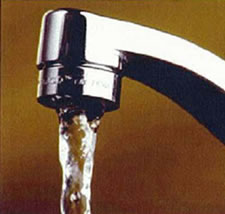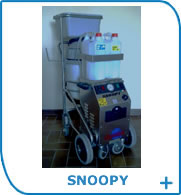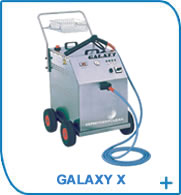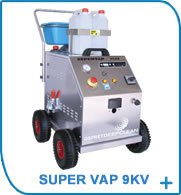Why Steam Cleaning?
Reasons why you should use dry-steam cleaning

Traditional cleaning methods remove dirt mechanically by water and tension-active components, but some dirt can remain in the pores of surfaces. Disinfectants also act mainly on the surface so bacteria can survive and be ready to grow again. The cleaned surface reflects the light and looks sparkling, but it is only a visual appearance of cleanliness.
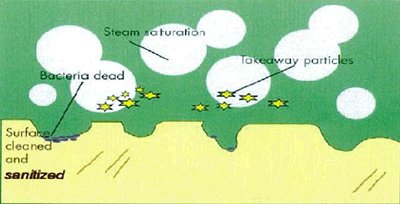
When you clean by steam high temperature steam reaches organic materials deep down in the surface. The dead organisms, even in the innermost pores, can then be removed by only using water and micro fibre cloths, effectively restricting further germ growth. Rinsing water, residuals and wastes are all 100% biodegradable.
Steam
Steam has been used to clean railways, ships and power stations for around 150 years. Mainly cleaning machinery and the grease and oil that goes with engineering, usually with a long lance and armoured gloves. We all know that because of high temperatures, steam will dissolve fats and oils and will kill bacteria (most die at 85 deg C). So it is only a question of safety and control. Steam is safer in terms of use at high temperature where the water particulate is smaller (dry steam) and cools more quickly, the 'saturated steam' from a kettle can scald faster than dry steam.
Care of the Environment
We are poisoning our planet with waste chemicals that we use for cleaning. Thousands of litres per day are poured down the drain each day and back into our environment. We use water at an alarming rate; most people think it's OK because rain fall from the sky and we have lots of it. It is not and we have not. Every year we have droughts and more water bans. We are reducing our resources.
The use of steam to clean reduces the use of chemicals by 80-90% and reduces the use of water by 90-95%. It also reduces the use of resources for heating the water at the same time.
The Quality Case, Hygiene and Safety
Mops and buckets use chemicals which are left smeared on floors or walls along with whatever is in the bucket, shuffling dirt into corners, edges around legs or supports on the base of equipment.
The bucket contains water, chemical and dirt, and the mop was probably dirty to start with. We know that water evaporates, the chemical goes hard and traps the dirt, leading to a build up in the grouts in floors and walls and within the surface of safety floors, because they are not perfectly flat. This makes the floors slippery and slow to dry.
Steam cleaning removes the dirt and sanitises at the same time. By cleaning at 130-180 deg C on every millimetre of surface it touches, releasing dirt and dissolving grease. The residual left is only pure water (damp not wet) which will dry quickly.
There are no residual deposits to contaminate foods
85% of accidents start with a slip caused by spills or chemical residue. Steam cleaning on a daily basis means taking off the dirt one day at a time.
Cleaning walls and canopies can be achieved standing on the floor, so compliance with health and safety at work is assisted without climbing.
The money case
The cost of cleaning in mops, buckets and machinery using chemicals, along with the cost of water and sewage as well as heating the water, the man hours used to achieve, in general, unsatisfactory results in terms of quality. To achieve better results it normally means more chemicals and more man hours and an increase in costs.
Steam cleaning removes most of the costs except man hours, although in the short term these can be reduced and in the long term, reduced considerably.
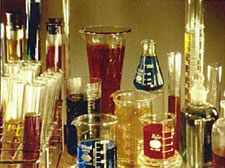
From this
to this:
